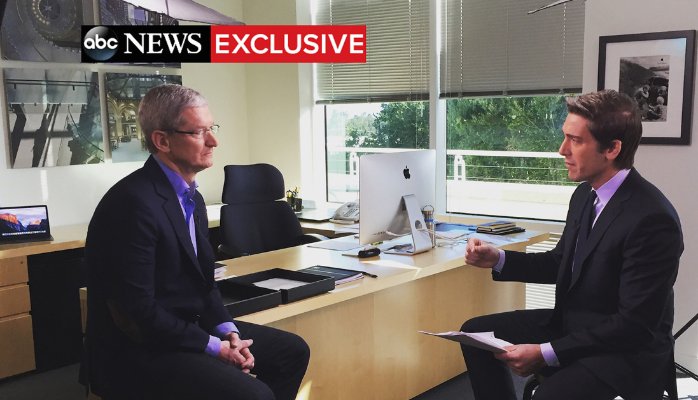Love or hate their products, one thing is indisputable — Apple has cracked the code on marketing technology in a way that creates product lust. Never is this finely honed skill more on display than during their now signature ‘Special Events’ where the latest must-have gadgets are unveiled to the world.
“But, what’s the magic behind making their products appear so magical?”
For the last ten years I’ve studied the Apple launch keynotes not as a consumer, but through the eyes of a marketer. While the products change year to year, here are five longstanding techniques from the Apple launch event playbook that any marketer can use to improve their presentations.
1. Sharing The Stage
Since the original iPhone launch event, Apple has mastered the concept of sharing the stage. What used to be the Steve Jobs show, has evolved into a carefully choreographed cast of characters. With human attention spans dropping sharply, today’s audiences crave dynamic, fast-paced, engaging experiences to keep them engaged. Nothing is boring than hearing the same voice drone on for a long time. Here are two techniques Apple uses to share the stage.
(i) Mixing Up Voices
This year’s iPhone X launch event included six personalities (eight if you include design chief Jony Ive via video and the late Steve Jobs in voice over) plus two, third party developers. This made for a mosaic of presentation styles, voices, tones and energies that keeps things interesting. While some spoke longer than others, looking at the breakdown of stage time shows that no one person dominated the show.
(ii) Keeping Segments Short
Looking at the run of show, another takeaway is that no one voice is ever speaking for more than 13 minutes at a time (that was Phil Schiller running through the features of iPhone X). Typically, each segment clocked in between 3 and 5 minutes at which point either a new speaker would take over, or a demo or video would be used to break up the dialogue. Here’s an example of how the continue to mix up presenters and presentation styles (dialogue, demos, videos)
I’ve heard event planners and marketers express concern over this rapid pace saying “we don’t want too much on and off, it will feel like a revolving door”. While this rapid pace might introduce more logistical complexity, it will also make for a more engaging presentation that feels like it has forward momentum.
One thing of note that was missing on their shared stage; diversity. Apple’s more recent keynotes have done a much better job of demonstrating gender and ethnic diversity than the iPhone X launch. Aside from Apple’s head of retail and a short cameo from a product manager, the presenters were mostly caucasian males. It feels like Apple has taken a step back here which is surprising, especially at a time when technology businesses are under intense scrutiny on the topic of diversity.
2. Mastering Multimedia
If it didn’t already jump out to you in the pie chart above, Apple expertly uses multimedia throughout the keynote. Over the course of the two hour keynote there were nine videos for a total of 12 minutes, or just over 10.5% of the run time. It’s no surprise as video can simplify complex technical topics and convey emotion. Here are three ways Apple uses video in their keynotes.
(i) Unveiling the goods
One big shift we’ve seen over the years is in how new devices are physically revealed. It used to be that Steve Jobs (or one of the execs) would take the phone out of their pocket, slide the computer out of an envelope, or pull a drape off a computer. Gone are those days. For the last several keynotes, Apple has used used short thirty-second videos (stingers) to unveil the latest new gadgets like Watch 3, iPhone 8 and iPhone X. It’s a brilliant move as the combination of music and fast paced visuals, culminating in a reveal can’t be matched by someone pulling something out of their pocket.
(ii) Simplifying Technology
We saw video used once again to help make complicated technology more approachable and easier to understand — like the way the new TrueDepth Camera system works, or how AirPower will provide charging to multiple devices simultaneously. Sure, some of these concepts could have been shown in a live demo, but you need to consider the overhead associated with a demo. Demos involve transition time, introduce risk of failure and take more time to show and tell simultaneously. Videos are processed by the human brain 60 times faster and, as Forrester points out, a 60 second video is worth 1.8 million words.
(iv) Giving us feels
Video is also very effective for creating a feeling with your audience because they help convey sight, sound and emotion all in one package. Apple used video to evoke a variety of feels during the presentation. There was the nostalgia and sadness triggered by the understated Steve Jobs voiceover set to soft piano; the excitement brought about by experiencing the new Apple Store designs (er, “Town Squares” as they’re now called); and the sense of optimism and togetherness stirred up by the Dear: Apple letters written by Apple Watch customers talking about how the timepiece impacted their lives far beyond telling time.
But, where were the demos?
Compared to other Apple special events, the iPhone X event was light on product demos – shocking with so many new announcements. Many of the new features were showcased through videos or on-screen animations instead of moving over to the signature demo podium. This was likely done to try and pack more content in but other tech companies considering this tactics beware – critics could paint picture that your products are vapourware and aren’t yet functional.
3. Heroes & Villains
Look closely at any Pixar film ever made and you’ll find that where there’s a hero, there’s a also villain. Heroes need villains like the day needs the night. Villains help the audience rally around the hero and create an obstacle that gives the hero a reason to exist . Villains don’t have to be competitors; they can be an idea, a problem or ‘the old way of doing things’. Apple has a longstanding tradition of weaving heroes and villains into their keynotes as a way of creating a problem that “only Apple can uniquely solve”. Check out these three examples of how Apple uses heroes and villains to introduce new products.
(i) Original iPhone launch (2007)
Steve Jobs goes to great lengths talking about how existing smartphones were neither smart, nor easy to use. He paints a vivid picture of how physical keyboards can’t be reconfigured to support new apps and ideas and how smartphone operating systems give you only a “baby web experience”. After he creates the villain (existing not-so-smartphones), he introduces the hero, iPhone.
(ii) Apple Pay
One of the best examples of late came from Tim Cook as he introduced Apple Pay. Before ever speaking the words Apple Pay, he talks at length about how “200 million times a day we scramble for our credit cards”. Through a video he shows us all the steps involved with paying using traditional plastic cards; how you can’t find it in your wallet; it sticks to other cards; it doesn’t swipe consistently – oh make it stop make it stop, it’s so very broken! Over the top? Perhaps, but it definitely paints a picture of the villain that our hero, Apple Pay, is about to conquer.
(iii) iPhone X
We saw fewer and much weaker examples of heroes and villains at the special event announcing iPhone X. One of the only in this presentation was when Phil Schiller introduced the new Super Retina OLED display being adopted by the iPhone X. Schiller first highlights the shortcomings of traditional OLED panels before contrasting against the Super Retina display and saying “this is the first OLED good enough for an iPhone”.
There were plenty of missed opportunities in this presentation to create nasty villains to help clear the way for new Apple heroes. A few that come to mind would be: vilifying other facial recognition platforms to pave the way for FaceID by talking about how they can be spoofed by pictures and don’t adapt to changing faces; playing up the pain associated with cords and lack of sockets to prime the audience for AirCharge; and unpacking the challenges tied to traditional phone designs to pave the way for a new truly edge to edge hardware (this last one is tricky because they’re straddling both hardware design worlds and don’t want to put iPhone 8 down to build up iPhone X).
4. Repetition, Repetition, Repetition
When an audience hears about something for the first time, it often goes over their heads. This is especially true of complex technology concepts. Apple does a good job of touching on the same features and concepts numerous times over the course of a presentation. After studying Apple special events over the last decade, it’s clear they follow mantra: “Tell them what you’re going to show them, show them, then tell you what you showed them”.
Take the way Apple introduced FaceID.
This can be a difficult pill for some marketers to swallow; they feel hitting the same topic again and again gets repetitive and the audience will check out. Quite the opposite. Repetition is needed for your key messages to be absorbed. Carving out time in your presentation to apply this technique might require making tradeoffs and showing fewer things, but those few things will be better understood.
5. Drawing a Map
A common Apple keynote technique that didn’t make an appearance at the launch of iPhone X is drawing a mental map of the presentation for the audience. Similar to presenting a table of contents at the beginning of a book, drawing a map means painting a picture of what will be covered during the presentation. During the presentation you can refer back to the map to understand where they are in the overall journey. Use this technique especially when you have a number of products or businesses to cover, or when each product update contains a number of sub-elements.
Apple has used this technique on many occasions, but none is more memorable than the original iPhone launch. Steve introduces the iPhone as a “widescreen iPod, a phone and an internet communications device” thereby creating a framework to guide the rest of the feature reveals and demos.
This slide (with the three icons) becomes a table of contents that is referred back to many times to signal to the audience which chapter of the presentation we’re in.
While we didn’t see this done explicitly for iPhone X, If you listen closely we do get cues from presenters that we’re about to move from one chapter to the next. As the discussion about a product nears the end, the presenter will say something like:
“And that’s iPhone 8. Glass and aluminum design, A11 Bionic chip, designed for AR, wireless charging”.
It’s a great wrap up technique that hammers home the key messages (repetition) and signals to the audience we’ve reached the end of that chapter (draw them a map).
You might not have the next game changing tech product to unveil in your next presentation but if you use focus on sharing the stage, mastering multimedia, using heroes and villains, employing repetition and creating a map, you’re one step closer to building a compelling narrative that will take your audience on a journey.


